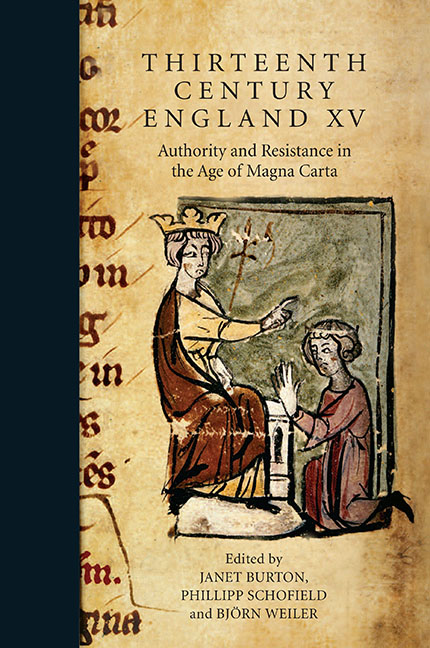 Thirteenth Century England XV
Thirteenth Century England XV The Visual Representation of Authority in the Historia Anglorum of Matthew Paris
Published online by Cambridge University Press: 11 June 2021
Summary
The opening pages of Matthew Paris's Historia Anglorum (BL, Royal MS 14 C. vii) provide the reader with an introduction to the themes of kingship and authority found throughout this manuscript and his work as a whole. The work opens with a sequence of images that shows the kings of England, the itineraries from London to Apulia, and the maps of the Holy Land and England within a broader European context, while at the same time marking indelibly the prominence given to the role of the monarch within the chronicle. The images play an important role not just in the framing of the history with these visual statements of royal authority but also, through the use of signa, highlighting the themes of authority and dissent found within the manuscript.
The thirteenth-century monk Matthew Paris (c. 1200–1259) was a prolific author and illuminator. He produced several chronicles of different sizes that were noted not only for the quality of his writing but also for the significant role he gave to images. These histories include the Chronica Majora (Cambridge, Corpus Christi College, MS 26, 16; BL, Royal MS 14 C. vii, fols 157r–218v), the Historia Anglorum (BL, Royal MS 14 C. vii, fols 10r–156v), the Abbreviatio Chronicorum (BL, Cotton MS Claudius D.vi, fols 2–94), while another Cotton manuscript, MS Nero D.i, also includes the Chronica Majora's Liber Additamentorum, the Gesta Abbatum, and the Vitae duorum Offarum. In addition Matthew's writings provided the basis for the Flores Historiarum (Manchester, Chetham Library MS 6712), produced for Westminster Abbey, and containing his distinctive hand on folios 170v–200v. While much of the discussion on the art has focused on the encyclopaedic Chronica Majora or the maps, the Historia Anglorum also provides opportunities to explore Matthew Paris's work further.
Paris began compiling this book in 1250, as he himself records. Unlike the Chronica Majora which began with the Creation, the Historia Anglorum covers a shorter timeframe, from the Norman Conquest until 1253. It does share in its use of marginal imagery and accompanying prefatory material features that appear in Paris's other chronicles, although no two manuscripts follow the same formula. The manuscript of the Historia Anglorum makes up the first 156 of the 232 folios. The final section of the Chronica Majora is also bound into this volume.
- Type
- Chapter
- Information
- Thirteenth Century England XVAuthority and Resistance in the Age of Magna Carta. Proceedings of the Aberystwyth and Lampeter Conference, 2013, pp. 181 - 206Publisher: Boydell & BrewerPrint publication year: 2015


